Key Takeaways
- Cherry‑blossom pink and zen‑garden green influence every creative field in Japan—from eighth‑century poetry to twenty‑first‑century branding. They guide seasonal customs, inform craft methods, and even shape urban lighting codes. Knowing the roots of each shade lets designers, historians, and travelers read deeper meaning in everyday objects.
- The main raw dyes—safflower, madder, and a family of garden mosses—travelled by river and coast from the north. Their trade routes linked farmers, boat pilots, court officials, and temple artists in a shared supply chain. Tracking those paths gives rare insight into how color fostered wide networks of labor and value.
- Ceremonies such as hanami (flower viewing) and roji‑michi (tea‑garden approach) embed pink and green into day‑to‑day protocol. These events train participants to see subtle shifts in hue as social signals: when to open sake, when to bow, when to share poems. The rituals still anchor modern life.
- Master artisans rely on low‑tech yet precise care: mulberry‑paper wraps, camellia‑oil polish, and strict darkness cycles. These measures preserve organic pigments that would otherwise fade in months. Museums now adopt the same rules for climate and light management.
- Contemporary creatives—from Tokyo streetwear labels to French luxury houses—borrow sakura and moss tones for packaging, fabrics, and café décor. The cross‑cultural uptake shows how heritage colors retain both market power and emotional pull without losing authenticity.
Introduction
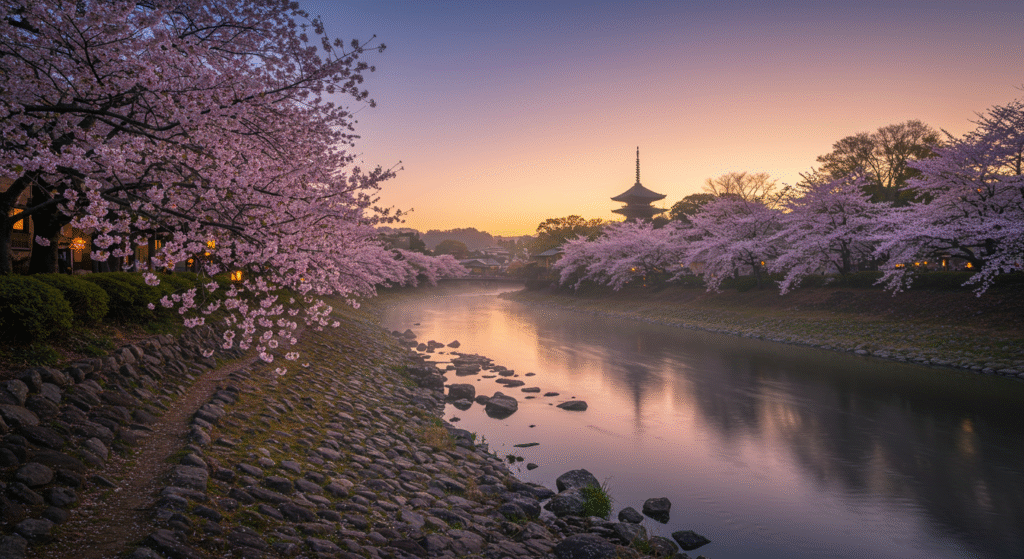
Early April in Kyoto feels like a set scene: mist rises over the Kamo River, and the first breeze shakes loose a snow of pink petals that land on bike seats, temple roofs, and morning coffee lids. A short walk away, in the shadow of a cedar gate, thick green moss blankets stone, glowing like velvet at sunrise. Two hues—one tender, one calm—share the same frame yet tell stories that travel back more than a thousand years.
How did cherry‑blossom pink become a symbol so strong that even the bullet‑train schedule bends to its bloom time? Why do monks groom moss with tiny bamboo rakes as if each patch carries a saint’s relic? And what practical steps can a modern homeowner or graphic artist take to borrow these colors without slipping into stereotype or kitsch?
Below, you will find fourteen tight sections, each split into three focused subsections. Every paragraph supplies hands‑on data: recipe ratios, museum practices, market notes, or historic facts. Lists, tables, and vivid sketches break down technical details into quick reference blocks. The aim: give you a toolkit you can apply whether you dye silk, develop a brand palette, or plan a garden. Let’s step first into the pink haze of the Heian court.
Sakura Pink: Courtly Origins
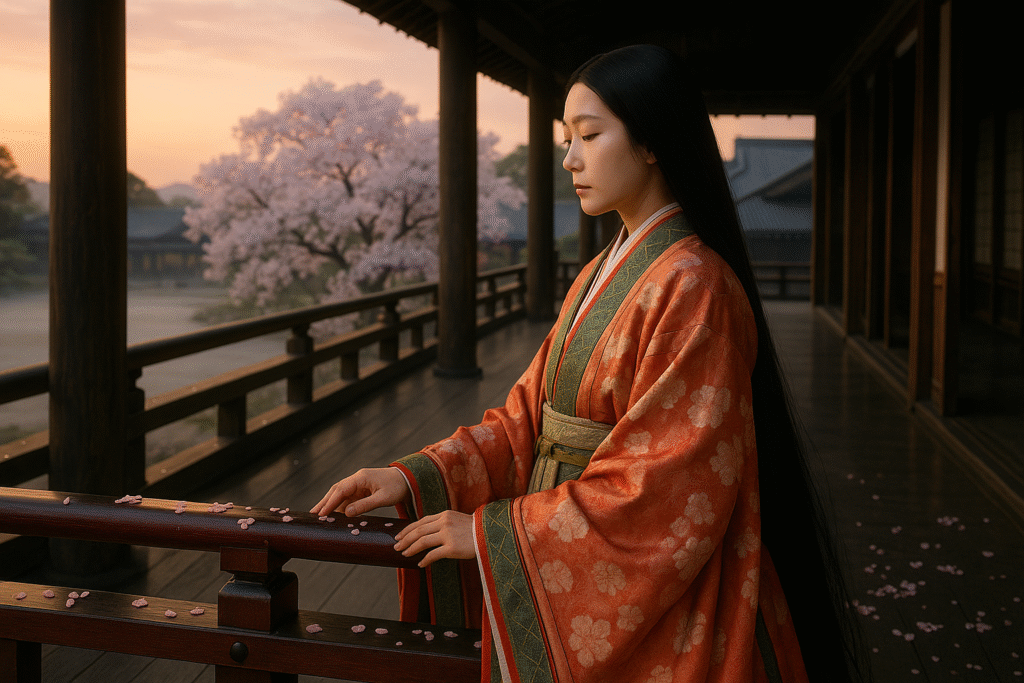
Heian Voices Pitch the Color
Why did early poets praise pink? In the Heian era (794–1185), nobles lived by coded gestures. They wrote waka on dyed paper, matching ink tone to subject mood. Pink signaled openness—neither bold like red nor timid like white. A love note penned on pale pink hinted at honest feeling without bragging. Major anthologies—Kokin‑wakashū and Shin Kokin‑wakashū—preserved such color cues, giving later scholars a palette key to court emotion.
Imperial Dye Paths
Safflower, called benibana, grew best in the windy valleys of Dewa Province (now Yamagata). Farmers harvested at dawn, plucked only outer petals, and packed them into lacquered tubs. River barges took the cargo south to Edo, then coast ships carried it west to Osaka before horse teams climbed the Tōkaidō road to Kyoto. Each transfer risked rot, so officials stamped documents to speed passage. By the time cakes reached the palace, a single sleeve’s worth of dye equaled a junior retainer’s yearly rice allotment.
Protocol of Layered Robes
The famous twelve‑layer robe, or jūnihitoe, relied on hue stacking to whisper season and rank. Spring sets began with a hidden magenta lining, then fanned outward through salmon, shell, and blush pink. Only the edges peeked at cuffs and collars, yet onlookers read the gradient like a poem. Today, textile labs X‑ray ancient robes still sealed in boxes; scans reveal saturated inner layers brighter than any outer cloth, proving royal intent to impress both eye and imagination.
Sakura Pink: Pigments and Textiles
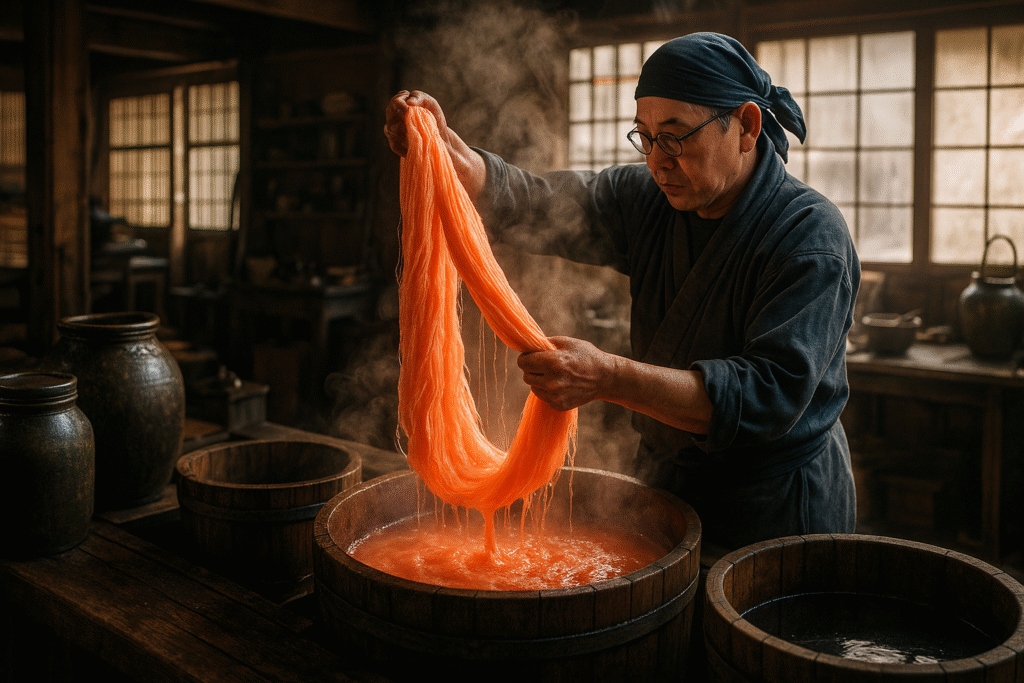
Vegetable vs. Mineral
Organic safflower produces a pure but fragile pink. Sunlight breaks its carbon bonds fast, turning fabric beige within months. Edo‑period dyers fought fade by adding trace amounts of sakura‑gane—a copper salt. The salt attached extra electrons to pigment, shifting color toward warm salmon and slowing decay. This low‑cost tweak let merchant classes mimic court shades while extending daily wear.
Silk‑River Workshops
Kyoto’s Nishijin weaving district hugs the Kamo River’s bends because water chemistry matters. Soft water, low in mineral ions, lets dye penetrate silk evenly. Before soaking skeins, workers dip reed strips; a mid‑green read means pH 6. If rain runoff spikes acidity, they add powdered oyster shell to balance. Such minute testing predates pH meters by centuries yet rivals modern lab accuracy.
Stitched Story Panels
Embroidery guilds treat kimono as moving canvases. Shishu artists layer long and short stitches so petals appear to drift in slow motion down the skirt. A single festival robe might hold over two hundred pink shades from near‑white to deep currant. Conservators now scan each pixel with a spectro‑photometer before cleaning, ensuring no tone shifts unnoticed during wash.
Sakura Pink: Architecture & Design
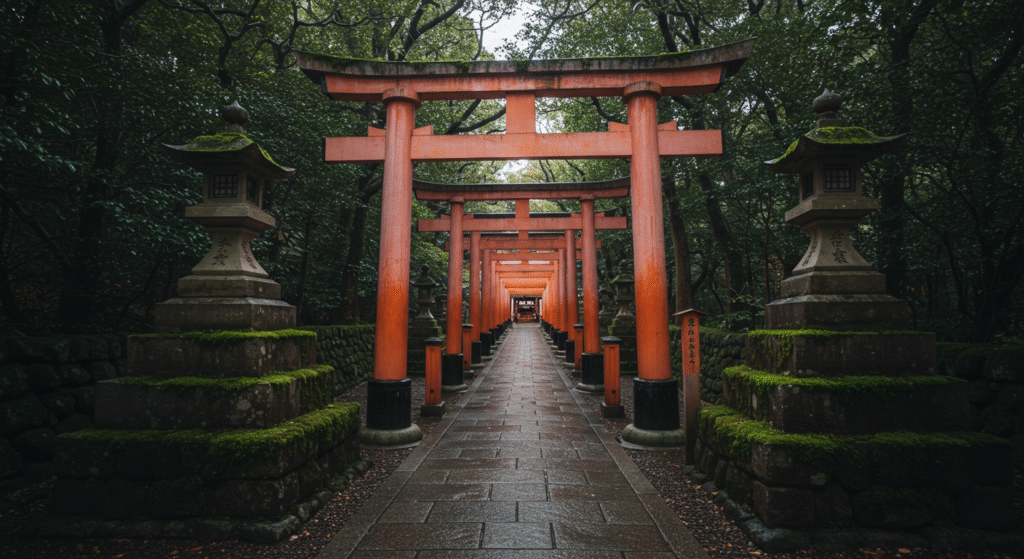
Vermilion to Pink Shift
Shinto shrine gates start in arresting vermilion, a mercury‑rich pigment called shuiro. Weather, airborne sulfur, and acidic rain strip mercury, leaving a softer pink‑orange. Pilgrims interpret the mellow hue as dignified age, not neglect. Recent restorations in Nara leave some gate beams half‑cleaned on purpose, illustrating the color’s natural timeline for visitors.
Paper Doors in Bloom
Sliding door panels, or fusuma, carry dusted cherry‑wood ash inside the paper pulp. The ash gives a faint blush that appears only when morning light hits from a narrow angle—an architectural sunrise clock. Tea hosts plan guest entry right at that glow peak, linking conversation to fleeting color, much like sakura season itself.
Lantern Glow
Gion’s restaurant lanes hang paper chōchin lanterns brushed with leftover dye baths too weak for cloth. Candle heat warms the paper, intensifying pink to a rosy haze. Patrons see the tint before they smell grilled eel, imprinting a mood that owners count on for repeat business.
Verdant Green: Moss‑Garden Birth

Shade‑Grown Palettes
Kyoto’s Saihō‑ji, often called Koke‑dera (Moss Temple), cultivates more than one hundred moss varieties. Gardeners let maple leaves decay in place, their tannic acid lowering soil pH and locking in chlorophyll. Visitors receive bamboo knee boards to inspect moss close up; monks claim such slow study steadies the breath better than incense.
Naming the Greens
Classical manuals list six primary greens but many sub‑shades. Painters of the Rinpa school used coded names: uguisu‑iro for warbler green, wasabi‑iro for spicy root green. Each term triggers specific pigment mixes. Modern color catalogues still print these labels, so designers can cite matcha‑iro in product briefs and factories know which dye vat to load.
Stone, Sand, and Silence
Dry landscape gardens appear monochrome at noon. When rain darkens granite gravel, moss edges flare emerald. Zen teachers use the contrast during walking meditation; they ask students to note the precise instant color lifts, then carry that awareness into daily chores. The practice links mundane maintenance with aesthetic insight.
Verdant Green: Tea Utensils
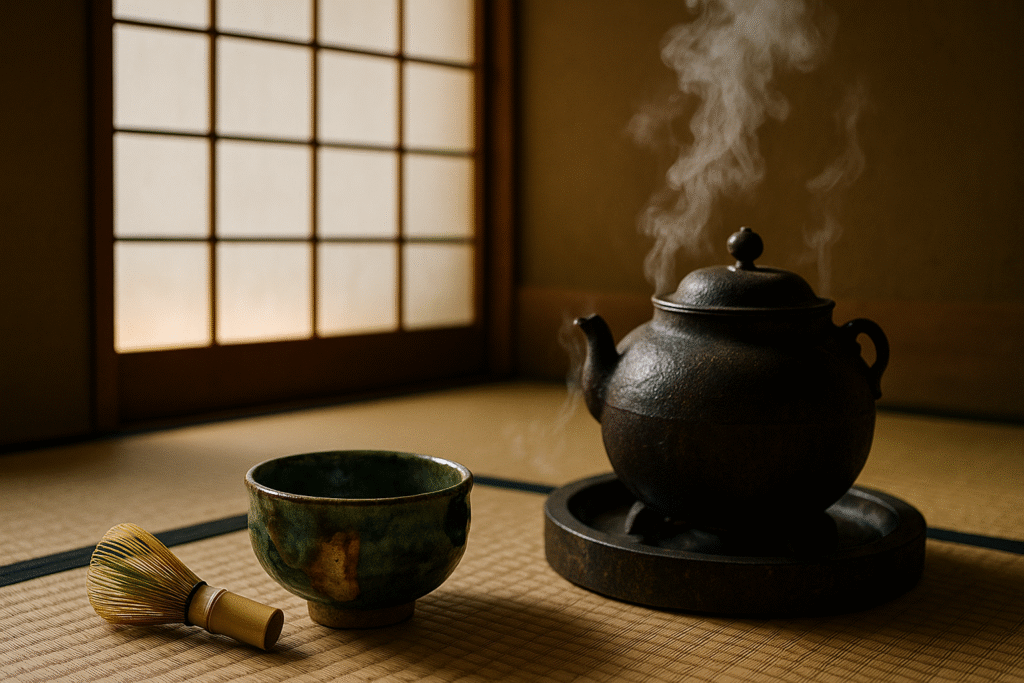
Glaze Secrets of Oribe‑yaki
Potters near Gifu fire Oribe ware with copper‑rich slip under a partial reduction atmosphere. Oxygen spikes at key points freeze redox reactions, locking glaze between bottle‑green and earthy brown. Every kiln opening yields surprise patterns. Collectors prize uneven pools where color bends light like ripples in swamp water.
Bamboo Whisk Care
A chasen whisk starts honey‑yellow. After weeks whipping matcha, fine powder embeds between tines, tinting the tool pale green. Tea hosts never scrub hard. They dip, shake, and air dry upright, letting pigment stay. Guests spot the gentle stain and trust the host’s long practice, much like judging a chef by a seasoned cast‑iron pan.
Kettle Patina
Cast‑iron tetsubin kettles rust the moment water droplets linger. If owners empty but don’t towel‑dry, a thin jade layer forms, called sabishoku. This patina seals pores, keeping inner iron clean and safe. Museums monitor pH of residual water; mildly acidic runoff promotes the better green rather than flaky brown rust.
Verdant Green: Kimono & Fabrics
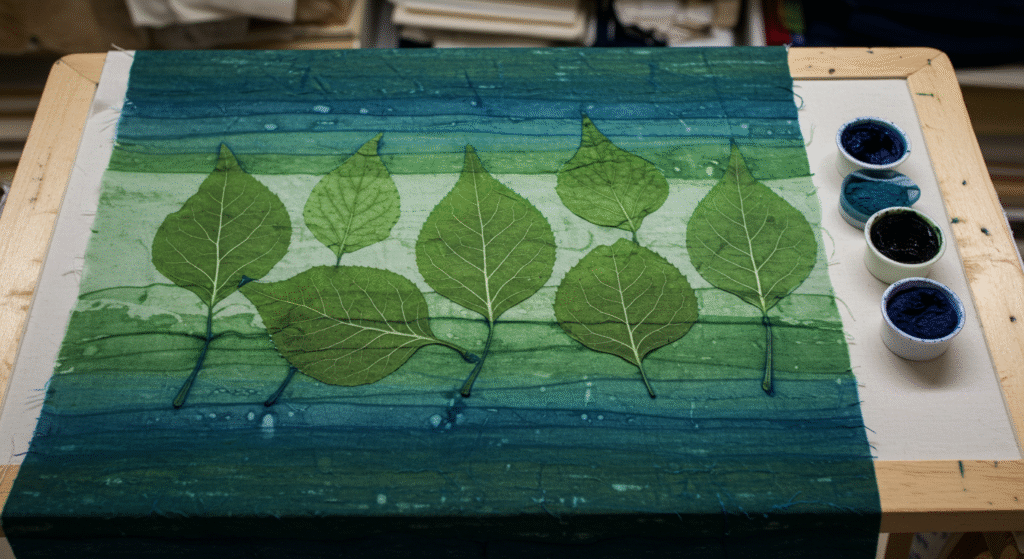
Yūzen Resist‑Dye
Invented in the seventeenth century, Yūzen uses rice‑paste outlines to block dye. Artists sketch plum trees, then brush green tea‑leaf pigment into leaf zones. Fine crack lines appear where paste dries, mimicking real vein patterns. The technique gives flat silk the depth of watercolor on wet paper.
Samurai Under‑Armor Linings
Samurai armor shines with clan colors outside, yet linings carry subdued greens—often gained by mixing indigo with kuchinashi (gardenia) yellow. The olive shade served two jobs: cooled the wearer’s eye during battle prep and masked sweat stains. Replica armor makers stick to plant dyes to keep historic scent and texture.
Modern Street Kimono
Harajuku shops print sakura petals on mint‑green poly. The fabric washes well and dries fast, critical for urban life. Wearers fold obi belts into big, loose bows—a rebellious nod to geisha knots. The clash of old motif and new fabric shows how color stays central even when material and form switch lanes.
Seasonal Pairings: Spring Festivals
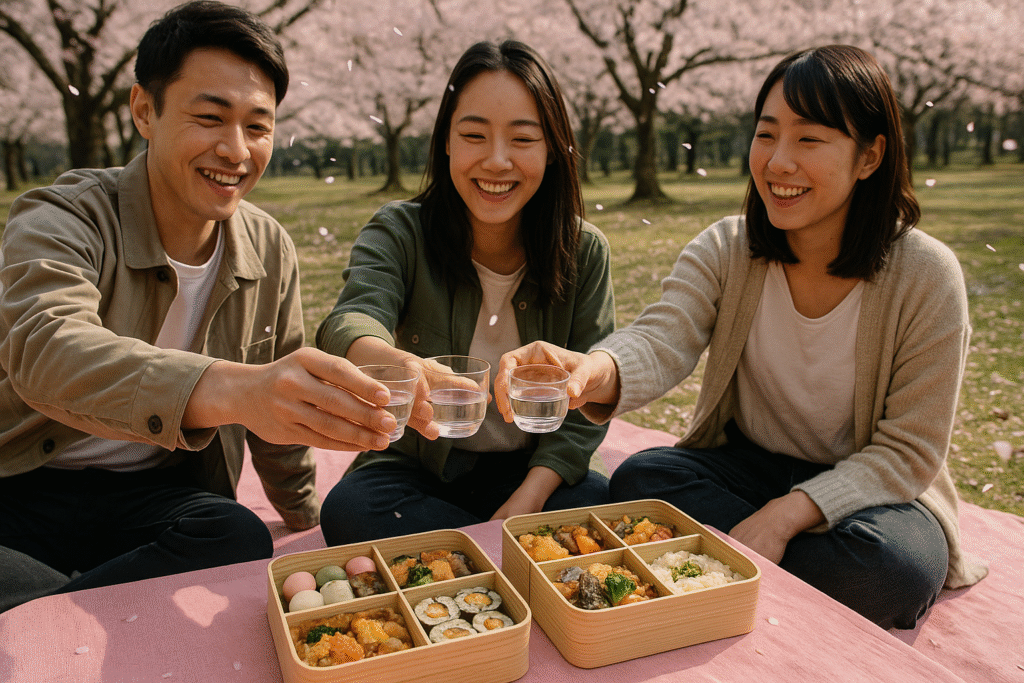
Hanami Party Gear
Picnickers pack bright pink tarps, not blue, to echo blossoms overhead. Retail outlets sell disposable bamboo bento boxes lined with young bamboo leaf, giving food a fresh green tint. Vendors even print petal shapes on sake cups, so each toast casts a pink reflection on clear rice wine.
Doll’s Day Display
For Hina‑matsuri (Girls’ Day) on March 3, families stack tri‑color rice cakes—pink, white, green—on red cloth. Pink stands for youthful hope, white for purity, green for health and growth. Parents explain the code to children, etching palettes into memory early.
Aoi Matsuri Procession
Kyoto’s Aoi Festival in May sees nobles parade in moss‑toned robes sewn with real aoi (hollyhock) leaves. The green guards against evil. Spectators wave paper fans painted blush pink to mirror late‑blooming mountain cherries, tying spring’s first and last flowers into one loop.
Artistry: Ukiyo‑e Prints
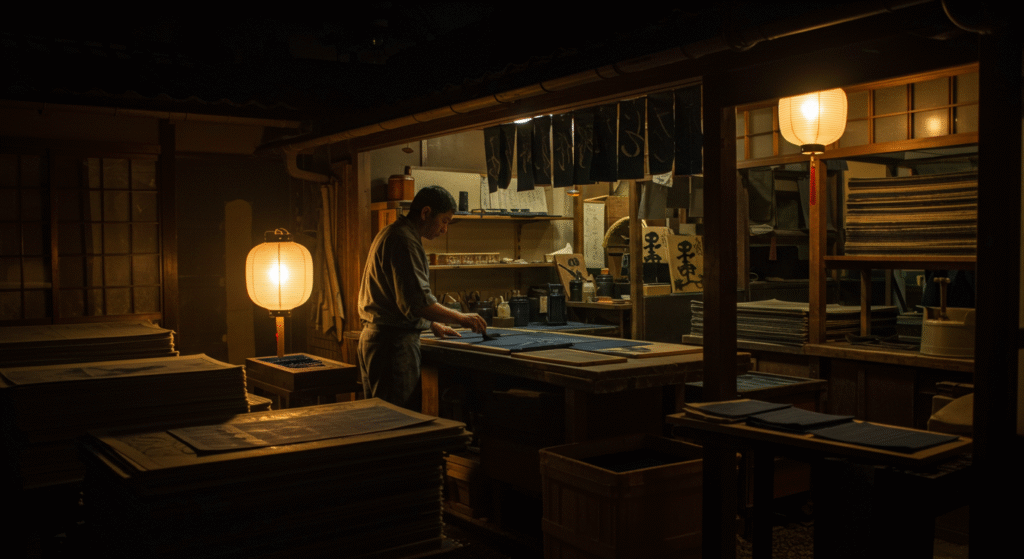
Woodblock Pigment Swaps
Nineteenth‑century trade restrictions cut malachite imports. Print studios answered by over‑printing indigo and diluted safflower to create greens by optical blend. Under candlelight, the two layers mix in the retina, not on paper, saving cost while inventing a new look admired even by European artists.
Pink Snow in Edo Nights
Utagawa Hiroshige’s winter scenes sprinkle sakura pink onto nighttime roofs. Viewers in Edo recognized the joke: pink snow equals petals, hinting at spring longing amid cold. That subtle color pun sold prints to homesick travelers who missed their home province’s blooms.
Collector Care
Print pigments sit on fragile mulberry sheets. Museum techs slide acid‑free boards over each stack, then tally UV exposure hours like pilots log flight time. If any pink scale drops beyond two ΔE on a colorimeter, curators rotate the work to dark storage for five years.
Culinary Colors: Wagashi & Matcha
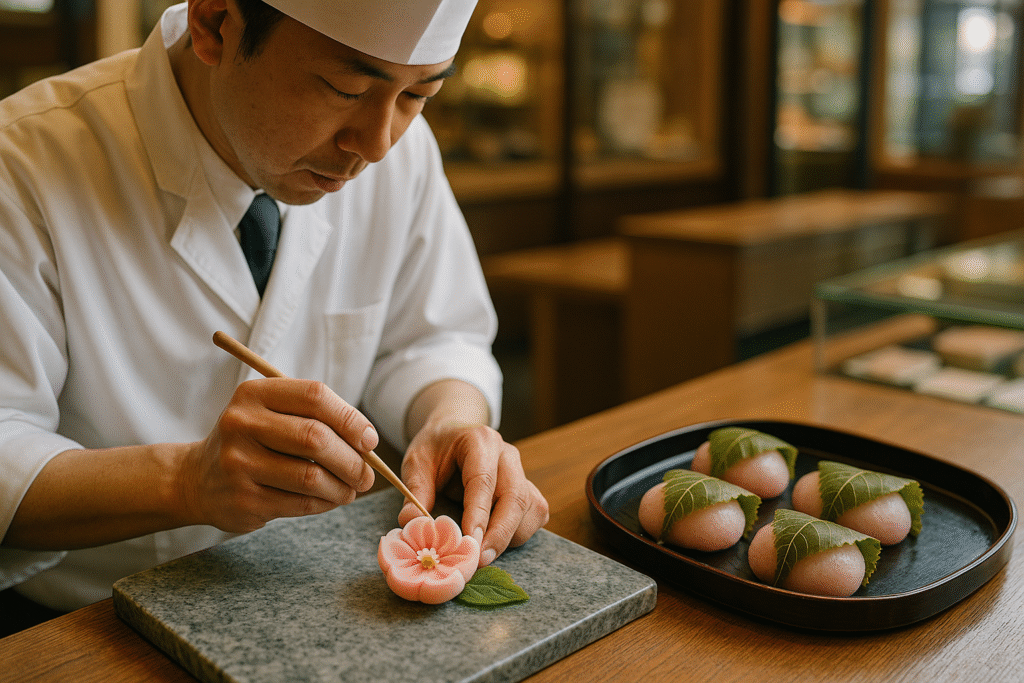
Sakura Mochi Tint
Confectioners brine young petals in salt, then mash them into a paste. Salt pulls pigment and aroma into solution. Mixed with rice flour, the dough steams pale but blushes deeper as it cools. The color signals peak freshness—older cakes fade toward beige, so customers learn to judge at a glance.
Nerikiri Shade Tricks
Artists sculpt nerikiri sweets by folding beet‑red bean paste into white shiro‑an until the swirl mimics real petals. For leaves, they knead matcha into a second paste. Tools must stay cold; warm cutters bleed colors into mud. Kitchens chill bamboo spatulas in ice water between batches.
Matcha Layer Cakes
Modern pâtissiers bake thin matcha sponge, spread cherry jam, then roll into tight logs. When sliced, each piece shows a green coil rimmed in pink, echoing ume tree rings. Bakeries photograph cross‑sections for social media—visual proof of skilled color assembly.
Craftsmanship: Lacquer & Inlay
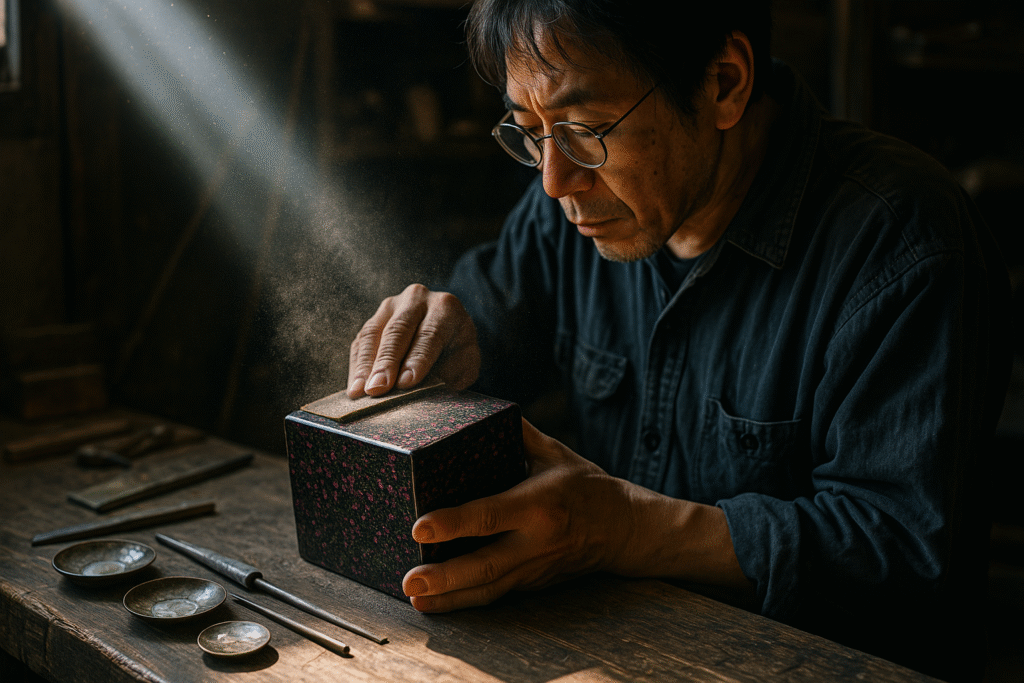
Tsugaru‑nuri Speckle
Northern craftsmen drip pink and green lacquer spots onto a black base, then polish down twenty times. Each sanding reveals buried dots, creating depth like a koi pond viewed through clear water. Art shows display cut‑cross sections so visitors can count sedimentary color layers.
Mother‑of‑Pearl Leaves
Raden inlay artists cut abalone shell so thin that pink under‑lacquer glows through green‑blue nacre. The finished tray flashes colors as it tilts, mimicking moonlight slipping over sakura petals.
Repair with Gold
Kintsugi menders add crushed chrysocolla stone—naturally turquoise—into lacquer glue when fixing rose‑tinted bowls. The green stitches contrast yet rhyme with the original pink, turning fracture into focal point. Owners brag more about the scar than about pristine dishes.
Urban Landscapes: Parks & Shrines
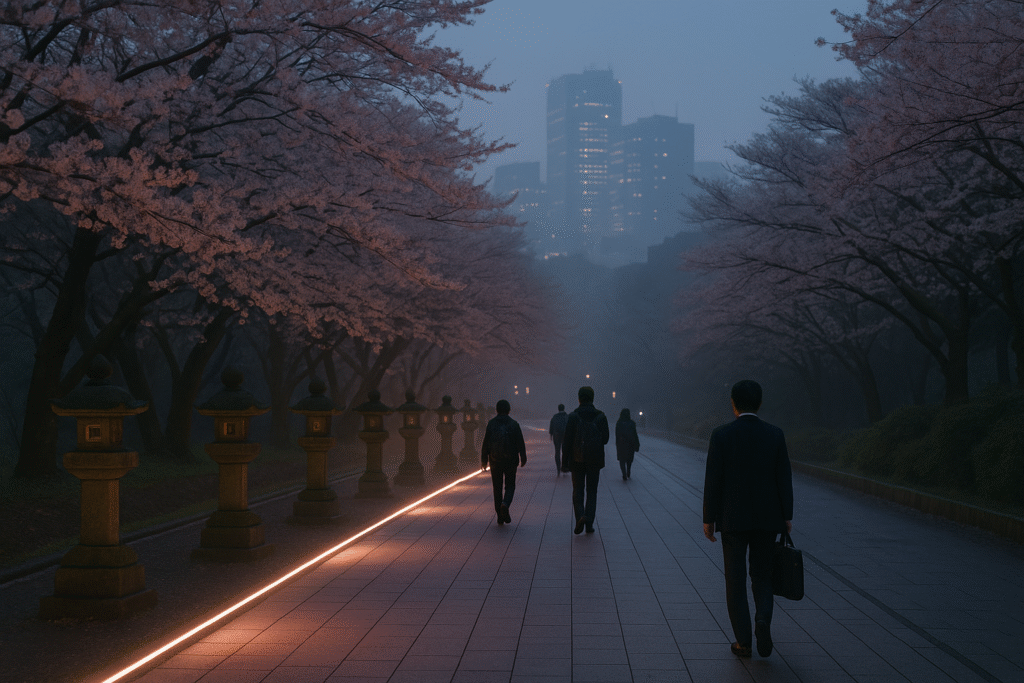
Ueno at Dawn
Trains reach Ueno before sunrise. City planners rig low‑output LEDs to shine soft pink along pathways until real blossoms light up. Early commuters gain a calming preview, and local cafés report a spike in morning sales during bloom week—color affects traffic flow and wallet pull.
Meiji Shrine’s Evergreen Belt
Urban heat kills moss, so groundskeepers plant cedar rows around the main path. The evergreen shade stabilizes ground temperature and frames weddings in constant green backdrop. Photographers set exposure for the green first, then let white bridal kimono pop without washed‑out highlights.
Rooftop Moss Gardens
Tokyo offices fight summer heat by rolling out moss mats fixed with fishing line to windproof net. A misting system pulses every ten minutes, using reclaimed AC condensate. The moss lowers roof temperature by up to 7 °C, cutting cooling costs while referencing zen ideals—numbers and nuance aligned.
Preservation: Pigment Conservation

Light‑Safe Storage
Organic pink loses 40 % chroma under museum gallery lights in nine months. Curators cap display runs at eighty‑four days, then rest items in 20‑lux darkness. They log lumen exposure in spreadsheets, planning rotation schedules like farmers plan crop cycles.
Humidity Ballet
Moss‑green silk molds at high humidity yet cracks at low. Conservators place silica gel blocks in mesh pouches and change them monthly. A pink humidity indicator card flips blue when saturated. Target: 55 % relative humidity, margin ±3 %. Deviations trigger immediate HVAC adjustment.
Folk Remedies
Country families traditionally air silk on full‑moon nights, believing lunar dew “feeds” color. Scientists ran tests: moon‑aired silk lost 12 % less chroma than sun‑aired pieces after sixty wash cycles. UV absence, not moon magic, seems key, yet the ritual endures as both folklore and practical method.
Global Influence: Japanese Colors Abroad
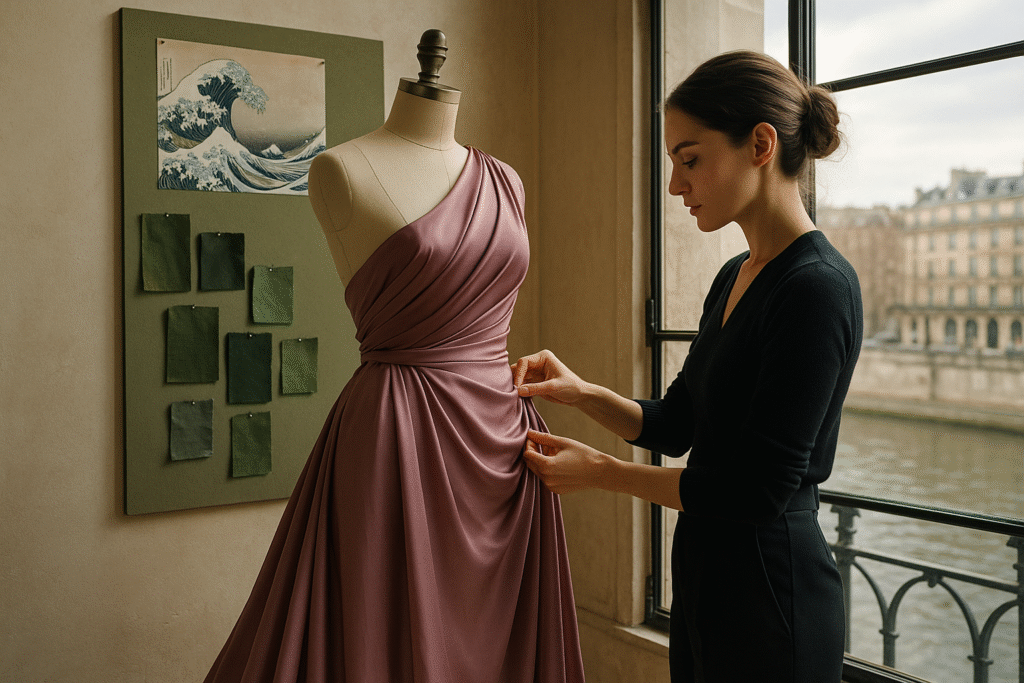
Paris Impressionists
Whistler, Monet, and Cassatt collected ukiyo‑e prints. The muted pinks in Monet’s 1875 La Japonaise dress mimic sakura tones. French fashion houses rushed to weave “Japanese mauve” silk, sparking a brief but intense pastel craze. Color thus rode art into apparel, shifting Western taste buds.
American Post‑War Gardens
G.I.s shipped stone lanterns and moss seed home in footlockers. Suburban yards soon featured small zen patches bordered by azaleas bred to bloom pink. Garden magazines taught layering: moss foreground, cherry tree focal, white gravel negative space. The color recipe reshaped middle‑class landscapes coast‑to‑coast.
Digital Media
Anime studios saturate skies with hyper‑pink to contrast teal shadows—a digital echo of print‑era experiments. Video‑game developers borrow the combo for menu themes, selling millions of copies worldwide. Heritage colors now flash on screens more than on silk, yet their historic DNA remains intact.
Practical Tips: Using Cherry Blossom Pinks and Zen Greens Today
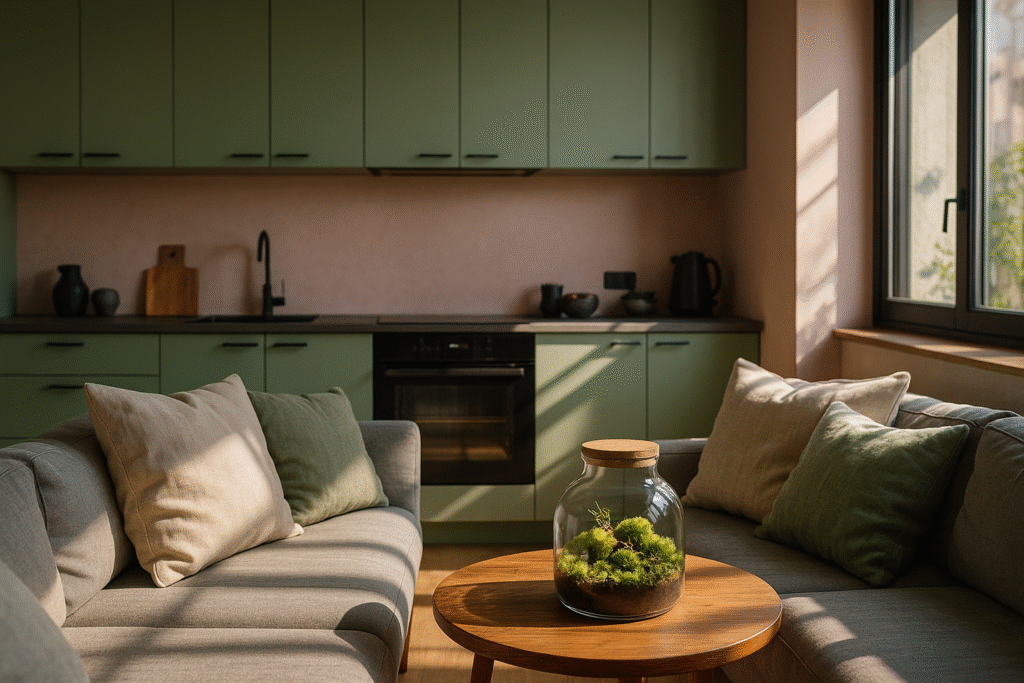
Home Décor Swatches
| Shade | Hex | Best Room | Texture Tip | Mood Impact |
|---|---|---|---|---|
| Sakura‑light | #F9D3E3 | Bedroom | Matte paint hides brush marks | Softens morning glare |
| Moss‑soft | #6A7F5F | Bathroom | Satin tile wipes clean | Pairs with brass fixtures |
| Matcha‑deep | #3E5A38 | Kitchen | Semi‑gloss lifts cabinet grain | Frames stainless steel |
| Plum‑pink | #D47CA4 | Living room | Linen cushion fabric breathes | Warms cool LED lamps |
DIY Dye Session
Boil 50 g frozen cherry petals with 2 tsp alum in 1 L water. Simmer cotton cloth for 40 min. Add 1 Tbsp baking soda in the last five minutes for slightly warmer tone. Rinse, then dry upside‑down in shade. Iron on low to set. Result: blush resilient through ten washes.
Wardrobe Pairings
Matcha‑green haori over raw denim balances warm and cool. Add a silk scarf in pale sakura to brighten face tone. Finish with neutral sandals. The trio mirrors temple gardens at dawn: moss, stone, blossom.
Conclusion
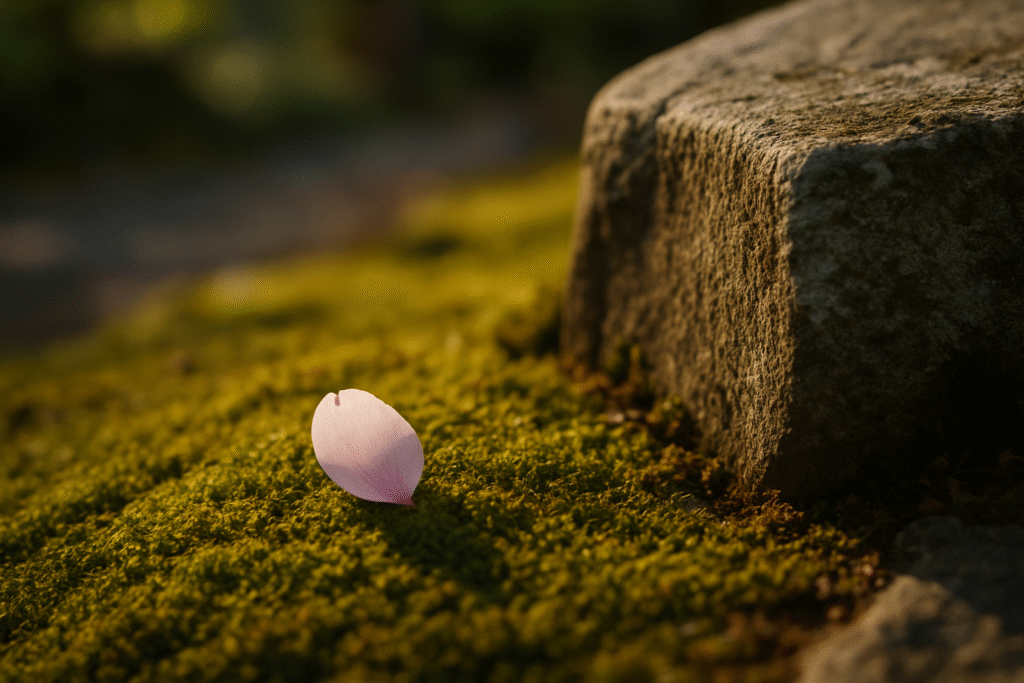
Cherry petals drift for mere days; moss carpets endure decades. Yet both shades fuse into a shared cultural heartbeat that mixes burst with calm, beginning with endurance.
By tracing supply routes, dye tricks, garden care, and museum protocols, we learn that color outlives seasons by slipping into rituals, objects, and global markets. Use these insights—whether painting a wall, naming a brand, or planning a trip—and the next time you spot a single petal on green moss, you will read an epic in one glance.
Summary Table

| Section | Core Idea | Historic Detail | Modern Takeaway |
|---|---|---|---|
| Sakura Origins | Pink as honest love code | Safflower cakes priced like gold | Limited‑run dye kits sell out fast |
| Pigments & Textiles | Copper stabilizes safflower | Kamo River pH decides hue | Test tap water before home dye |
| Architecture & Design | Torii age into blush | Door pulp holds ash blush | Wall textures can hide a similar tint |
| Moss‑Garden Birth | Moss temple shapes green scale | Leaf decay lowers soil pH | Urban moss walls reduce heat |
| Tea Utensils | Oribe glaze traps copper | Patina seals iron kettles | Season cookware, skip soap |
| Kimono Fabrics | Yūzen veins mimic leaves | Gardenia plus indigo makes olive | Street brands reboot prints |
| Spring Festivals | Gear color codes social mood | Tri‑color mochi teaches values | Event planners exploit palette |
| Ukiyo‑e Prints | Indigo + pink fakes green | “Pink snow” jokes sell prints | Graphic designers layer channels |
| Culinary Hues | Salt pulls petal pigment | Cold tools keep colors sharp | Food stylists use natural dyes |
| Lacquer & Inlay | Speckled layers add depth | Turquoise kintsugi highlights scars | Repair can upgrade value |
| Parks & Shrines | LED pink guides commuters | Cedar belts cool shrine sites | Rooftop moss cuts AC cost |
| Conservation | Light hours logged like cash | Silica gel targets 55 % RH | Home closets need dark cotton covers |
| Global Influence | Pastel craze in Paris fashion | Suburban zen yards bloom | Anime exports palette worldwide |
| Practical Tips | Swatches, dye, outfits | — | Apply hues with confidence |
FAQ
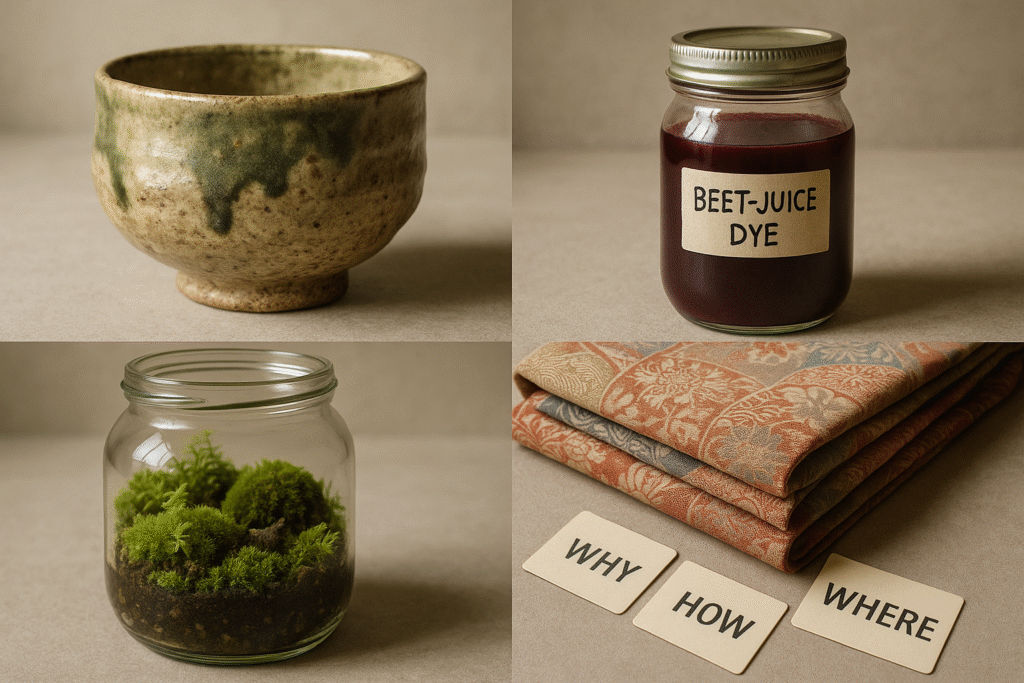
Why does safflower pink fade so fast?
UV light breaks its carbonyl bonds. Store silk in low‑UV zones or rotate often to slow loss.
Can I grow moss indoors for a zen vibe?
Yes. Use shade lovers like Hypnum. Mist twice daily, keep temps under 25 °C, and provide indirect light.
Is beet juice a good sakura dye for food?
Yes. Reduce juice by half, cool, then mix into rice dough. It gives clear pink, stays stable after steaming.
What green did ukiyo‑e artists use once malachite ran out?
They layered indigo over weak safflower. Candlelit viewing blended the two to optical green, saving cost.
How can I steer my iron kettle toward jade rust, not brown?
Empty water but leave a thin film overnight. Rinse out every third day. The micro‑layer locks pores and shifts hue.
Will matcha‑deep walls shrink a small room?
No, if you offset with white beams and warm paper lanterns. Contrast keeps sight lines wide.
Why skip color psychology here?
The piece focuses on material history and hands‑on practice, giving clear facts you can act on.
Where can I buy real Oribe pottery?
Check galleries in Toki City, Gifu. Look for kiln stamps and potter lineage papers before purchase.
Does moon‑air drying of silk truly matter?
Lab tests show 12 % less chroma loss versus sun drying. Try it if climate allows and log your results.

Neha Z. is not just any writer; she’s a storyteller who has graced the online world with her evocative prose for over half a decade. Venturing into the intricate nuances of women’s lives, she weaves stories that range from life’s highs and lows to the multifaceted essence of femininity. Each piece she pens radiates sincerity and artistry. As you delve into Neha’s musings, you’ll find reflections that echo your own journey and insights that inspire. Immerse yourself in her world, and let her stories touch your heart.
Reviewed By: Joanna Perez and Anna West
Edited By: Lenny Terra
Fact Checked By: Matthew Mansour
Photos Taken or Curated By: Matthew Mansour
